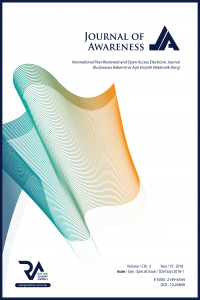Öz
Nowadays smartphones security problems are not just a matter of technological factors but human factor is involved as well. The aim of this study is to investigate smartphone security practices of users in Albania and how is presented their security awareness. To accomplish the objectives, a questionnaire was conducted. The results from 103 participants are presented and analysed.
Anahtar Kelimeler
smartphones questionnaire survey security practices security awareness
Kaynakça
- CAUSEY, B., 2013. Strategy: How to Conduct an Effective IT Security Risk Assessment, InformationWeek Reports.
- CONOLLY, T. & AYTES, K., 2003. A Research Model for Investigating Human Behavior Related to Computer Security.
- COSTANTINO, G., MARTINELLI, F., SARACINO, A. &SGANDURRA, D., 2013. Towards enforcing on-the-fly policies in BYOD environments. Gammarth, IEEE, pp. 61-65.
- GAJAR, P. K., GHOSH, A. &RAI, S., 2013. Bring Your Own Device (BYOD): Security risks and mitigating. Journal of Global Research in Computer Science, April.4(4).
- GOOD, N. et al., 2005. Stopping spyware at the gate: A user study of privacy, notice and spyware.
- HA, E. et al., 2012. Android Permissions: User Attention, Comprehension, and Behavior. Washington DC.
- KEARNEY, W. D. &KRUGER, H. A., 2006. A prototype for assessing information security awareness. Computers and Security, Volume 25, pp. 289-296.
- KELLEY, P. G., BENISCH, M., CRANOR, L. F. &SADEH, N., 2011. When are users comfortable sharing locations with advertisers?. Vancouver, pp. 2449-2452.
- KLEINBERG, J., 2007. The wireless epidemic. Nature, p. 287–288.
- LAROSE, R., RIFON, N. &LEE, D., 2008. Keeping our network safe: a model of online protection behaviour. Behaviour & Information Technology, 27(5), pp. 445-454.
- LAWTON, G., 2008. Is It Finally Time to Worry about Mobile Malware?, IEEE Computer.
- LAZARUS ALLIANCE, 2017. It’s Time to Get Serious About Education Cyber Security. [Online] Available at: https://lazarusalliance.com/education-cyber-security/ [Accessed November 2015].
- LEADERS, 2015. Planet of the phones - The smartphone is ubiquitous, addictive and transformative. TheEconomist.
- MINIWATTS MARKETING GROUP, 2017. World Internet Users Statistics and 2017 World Population Stat. [Online] Available at: http://www.internetworldstats.com/stats.htm [Accessed 2017].
- MOTIEE, S., HAWKEY, K. & BEZNOSOV, K., 2010. Do Windows users follow the principle of least privilege? Investigating user account control practices.. New York.
- National Cyber Security Alliance (NCSA), 2010. State of Cyberethics, Cybersafety, and Cybersecurity Curriculum in the U.S: NCSA.
- RADER, E. & WASH, R., 2015. Too Much Knowledge? Security Beliefs and Protective Behaviors Among United States Internet Users.
- RRAPAJ, A., 2015. Market Overview and Regulation in Albania. [Online] Available at: http://www.infocomalbania.com/presentations-2015/rapaj.pdf [Accessed November 2017].
- RUGGIERO, P. & FOOTE, J., 2011. Cyber Threats to Mobile Phones, s.l.: United States Computer Emergency Readiness Team (US-CERT).
- SMITH, I. E. et al., 2005. Location Disclosure to Social Relations: Why, When, & What People Want to Share. Portland, Oregon.
- SPITZNER, L., n.d. Measuring Change in Human Behavior. Mosone Center, San Francsico.
- WASH, R., 2010. Folk Models of Home Computer Security.
Öz
Kaynakça
- CAUSEY, B., 2013. Strategy: How to Conduct an Effective IT Security Risk Assessment, InformationWeek Reports.
- CONOLLY, T. & AYTES, K., 2003. A Research Model for Investigating Human Behavior Related to Computer Security.
- COSTANTINO, G., MARTINELLI, F., SARACINO, A. &SGANDURRA, D., 2013. Towards enforcing on-the-fly policies in BYOD environments. Gammarth, IEEE, pp. 61-65.
- GAJAR, P. K., GHOSH, A. &RAI, S., 2013. Bring Your Own Device (BYOD): Security risks and mitigating. Journal of Global Research in Computer Science, April.4(4).
- GOOD, N. et al., 2005. Stopping spyware at the gate: A user study of privacy, notice and spyware.
- HA, E. et al., 2012. Android Permissions: User Attention, Comprehension, and Behavior. Washington DC.
- KEARNEY, W. D. &KRUGER, H. A., 2006. A prototype for assessing information security awareness. Computers and Security, Volume 25, pp. 289-296.
- KELLEY, P. G., BENISCH, M., CRANOR, L. F. &SADEH, N., 2011. When are users comfortable sharing locations with advertisers?. Vancouver, pp. 2449-2452.
- KLEINBERG, J., 2007. The wireless epidemic. Nature, p. 287–288.
- LAROSE, R., RIFON, N. &LEE, D., 2008. Keeping our network safe: a model of online protection behaviour. Behaviour & Information Technology, 27(5), pp. 445-454.
- LAWTON, G., 2008. Is It Finally Time to Worry about Mobile Malware?, IEEE Computer.
- LAZARUS ALLIANCE, 2017. It’s Time to Get Serious About Education Cyber Security. [Online] Available at: https://lazarusalliance.com/education-cyber-security/ [Accessed November 2015].
- LEADERS, 2015. Planet of the phones - The smartphone is ubiquitous, addictive and transformative. TheEconomist.
- MINIWATTS MARKETING GROUP, 2017. World Internet Users Statistics and 2017 World Population Stat. [Online] Available at: http://www.internetworldstats.com/stats.htm [Accessed 2017].
- MOTIEE, S., HAWKEY, K. & BEZNOSOV, K., 2010. Do Windows users follow the principle of least privilege? Investigating user account control practices.. New York.
- National Cyber Security Alliance (NCSA), 2010. State of Cyberethics, Cybersafety, and Cybersecurity Curriculum in the U.S: NCSA.
- RADER, E. & WASH, R., 2015. Too Much Knowledge? Security Beliefs and Protective Behaviors Among United States Internet Users.
- RRAPAJ, A., 2015. Market Overview and Regulation in Albania. [Online] Available at: http://www.infocomalbania.com/presentations-2015/rapaj.pdf [Accessed November 2017].
- RUGGIERO, P. & FOOTE, J., 2011. Cyber Threats to Mobile Phones, s.l.: United States Computer Emergency Readiness Team (US-CERT).
- SMITH, I. E. et al., 2005. Location Disclosure to Social Relations: Why, When, & What People Want to Share. Portland, Oregon.
- SPITZNER, L., n.d. Measuring Change in Human Behavior. Mosone Center, San Francsico.
- WASH, R., 2010. Folk Models of Home Computer Security.
Ayrıntılar
| Birincil Dil | İngilizce |
|---|---|
| Bölüm | Araştırma Makalesi |
| Yazarlar | |
| Yayımlanma Tarihi | 10 Ocak 2019 |
| Yayımlandığı Sayı | Yıl 2018 Cilt: 3 Sayı: 5 |


